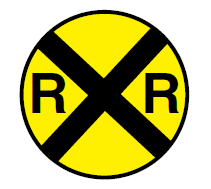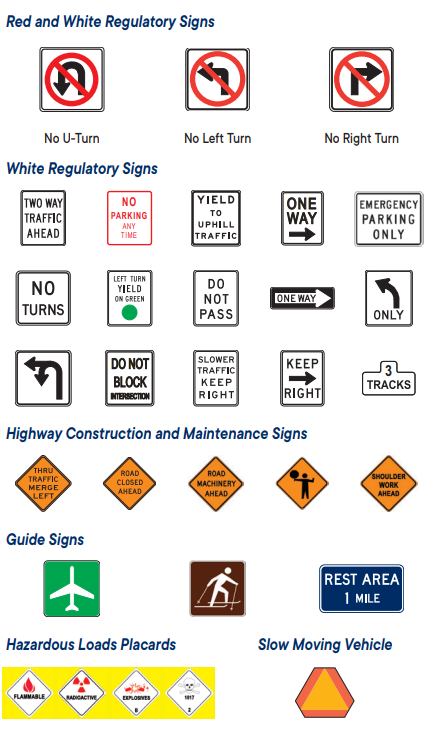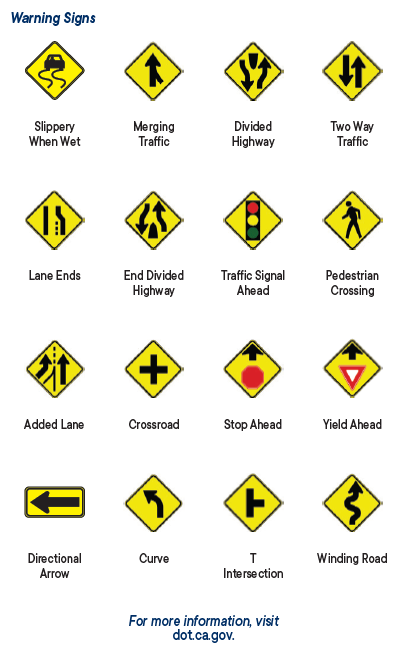CHAPTER ONE: FOREWORD
§Definitions
“Traffic Enforcement Agency” or “Traffic Regulator” refers to any department or agency that is employed by the Government to enforce traffic regulations within the city.
“Peace Officer” refers to any local, state or federal law enforcement officer or public official responsible for enforcing local, state or federal laws to keep the peace.
"Road" refers to any city-owned property that directly utilizes the area for public use where traffic enforcements are endorsed.
CHAPTER TWO: TRAFFIC REGULATIONS
Traffic Signals
Solid Red Light

A red traffic signal light means STOP.
Solid Yellow Light

A yellow traffic signal light means CAUTION. The light is about to turn red. When you see a yellow traffic signal light, stop, if you can do so safely. If you cannot stop safely, cautiously cross the intersection.
Solid Green Light

A green traffic signal light means GO. You should still stop for any vehicle, bicyclist, or pedestrian in the intersection. Only proceed if you have enough space without creating a danger to any oncoming vehicle, bicyclist, or pedestrian. Do not enter the intersection if you cannot get completely across before the traffic signal light turns red.
Traffic Light Not Working
When a traffic light is not working, stop as if the intersection is controlled by STOP signs in all directions. Then proceed cautiously when it is safe to do so.
What Traffic Lights do I obey?
You must obey all traffic lights that are at intersections. Traffic lights that are not at intersections are considered part-time traffic lights; where you only need to obey them when there is high density of traffic. Normally indicators will flash above the signal controller to make you aware when dense traffic (heavy congestion) is in place. If no signal controller is active, only obey intersection traffic lights.
Pedestrian Signals and Signs
WALK or Walking Person

You may cross the street.
Don’t Walk or Raised Hand

You may not cross the street.
Flashing Don’t Walk or Flashing Raised Hand
Do not start crossing the street. The traffic signal light is about to change. Drivers must yield to pedestrians, even if the Don’t Walk light is flashing.
Pedestrian Push Button
This is used to activate the Walk or Walking Person signal.
No Pedestrian Signals
If there are no pedestrian signals, obey the vehicle traffic signals.
Signs
Obey all warning signs regardless of their shape or color.
STOP Sign

Make a full stop before entering the crosswalk or at the limit line. If there is no limit line or crosswalk, stop before entering the intersection. Check traffic in all directions before proceeding.
Red YIELD Sign

Slow down and be ready to stop to let any vehicle, bicyclist, or pedestrian pass before you proceed.
Red and White Regulatory Sign

Follow the sign’s instruction. For example, DO NOT ENTER means do not enter the road or ramp where the sign is posted.
WRONG WAY Sign

If you enter a roadway against traffic, DO NOT ENTER and WRONG WAY signs may be posted. When it is safe, back out or turn around. If you are driving at night, you will know you are going the wrong way if the road reflectors shine red in your headlights.
Red Circle with a Red Line Through It

The picture inside the circle shows what you cannot do and may be shown with words.
Yellow and Black Circular Sign or X-shaped Sign

You are approaching a railroad crossing. Look, listen, slow down, and prepare to stop. Let any trains pass before you proceed.

Many railroad crossings also have a blue and white sign to tell you what to do if there is an emergency on or near the tracks, or if your vehicle has stalled on the tracks.
Diamond-shaped Sign
Warns you of specific road conditions and dangers ahead.
White Rectangular Sign
Communicates many important rules you must obey.
Warning Signs
Warns of conditions related to pedestrians, bicyclists, schools, playgrounds, school buses, and school passenger loading zones.

 Right-of-Way Rules: Who Goes First?
Right-of-Way Rules: Who Goes First?
Right-of-way rules help you understand who goes first when vehicles, pedestrians, and bicyclists meet on the road. The vehicle that arrives to the intersection first has the right-of-way. Other vehicles, bicyclists, and pedestrians must wait for the person who has the right-of-way. Never assume that other drivers will give you the right-of-way. Give up your right-of-way when it will help prevent collisions.
Intersections
An intersection is any place where one road meets another road. Controlled intersections have signs or traffic signal lights. Uncontrolled and blind intersections do not. Before entering an intersection, look left, right, and ahead to check for vehicles, bicyclists, and pedestrians. Be prepared to slow down and stop if necessary. Pedestrians always have the right-of-way. Here are some right-of-way rules at intersections:
Without STOP or YIELD signs: The vehicle that arrives to the intersection first has the right-of-way. However, if a vehicle, pedestrian, or bicyclist gets to the intersection at the same time as you, give the right-of-way to the vehicle, pedestrian, or bicyclist on your right. If you approach a stop sign and there is a stop sign on all four corners, stop first and proceed as above.
T intersections without STOP or YIELD signs: Vehicles, bicyclists, and pedestrians on the through road (continuing to go straight) have the right-of-way.
Turning left: Check for pedestrians. Give the right-of-way to any pedestrian or approaching vehicle that is close enough to be dangerous.
Turning right: Always check for pedestrians crossing the street, and motorcycles and bicycles riding next to you.
Green traffic signal light: Proceed with caution. Pedestrians have the right-of-way.
Entering traffic: When entering traffic, you must proceed with caution and yield to the traffic already occupying the lanes. It is against the law to stop or block an intersection where there is not enough space to completely cross before the traffic signal light turns red.
Roundabouts
In a roundabout, traffic travels in one direction around a central island.
How to use a roundabout:
*From left to right: Tricycle, Quadricycle, Standard Wheelchair, Electric Wheelchair.

Although pedestrians have the right-of-way, they also must follow the rules of the road.
When there is a pedestrian crossing a roadway with or without a crosswalk, you must use caution, reduce your speed, or stop to allow the pedestrian to safely finish crossing.
Other things to keep in mind:
Do not pass a vehicle stopped at a crosswalk. You may not be able to see a pedestrian crossing the street.
If a pedestrian makes eye contact with you, they are ready to cross the street. Yield to the pedestrian.
Always allow pedestrians enough time to safely cross a street as some groups such as seniors, people with small children, and people with disabilities may require extra time.
Crosswalks
A crosswalk is the part of the road set aside for pedestrians to safely cross the road. They are often marked with white lines. School crossings may have yellow crosswalk lines. Not all crosswalks are marked.
Pedestrians have the right-of-way in marked or unmarked crosswalks. If there is a limit line before the crosswalk, stop at the limit line and allow pedestrians to cross the street.
Some crosswalks have flashing lights. Whether or not the lights are flashing, look for pedestrians and be prepared to stop.
Pedestrians who are Blind
Pedestrians using guide dogs or white canes have the right-of-way at all times. These pedestrians are partially or totally blind. Be careful when you are turning or backing up. This is particularly important if you are driving a hybrid or electric vehicle because blind pedestrians rely on sound to know there is a vehicle nearby.